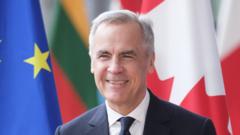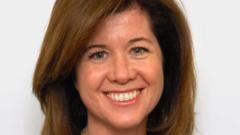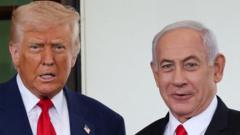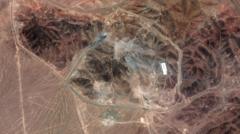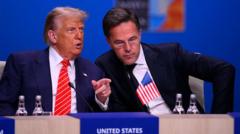With Canadians casting their votes today, the election showcases a tight race between Liberal leader Mark Carney and Conservative rival Pierre Poilievre. President Trump's previous interactions have ignited voter concerns, shifting the political balance as Canadians navigate a pivotal moment in their democracy.
Canadians at the Polls: A Nation's Choice Amid Turmoil

Canadians at the Polls: A Nation's Choice Amid Turmoil
As Canada votes for its next prime minister, the emergence of the Liberal Party led by Mark Carney signals a dramatic shift in the political landscape amid President Trump's controversial remarks.
---
**Article Text:**
Current time in Ottawa: 5:03 p.m. April 28. Updated April 28, 2025, at 4:54 p.m. ET.
Canadians are heading to the polls in a crucial election that will determine the nation’s leadership, its response to President Trump's economic threats, and its future health amid global upheaval. Opinion polls indicate a tight contest, with the Liberal Party, now led by Prime Minister Mark Carney, holding a slight edge over the Conservative Party and its leader, Pierre Poilievre. As voters cast their ballots for their parliamentary representatives today, the stakes are high: the leader whose party commands the most seats will assume the role of prime minister.
Three additional parties, including the left-leaning New Democratic Party, the Greens, and the Bloc Quebecois focusing on Quebec sovereignty, also vie for positions in the House of Commons, where 343 seats are available. Just months ago, the Conservatives were comfortably leading public sentiment by over 25%, with Poilievre seemingly poised for victory. However, the resignation of long-standing PM Justin Trudeau, coupled with inflammatory trade policies from President Trump, has reshaped the electoral landscape. With Carney at the helm, the Liberals have quickly gained traction, positioning themselves as better equipped to navigate relations with Trump.
In Canada’s electoral system, voters select representatives from their local districts, known as ridings, and the party securing the most seats forms the governing administration, even without a majority. The distinct personalities and visions of Carney and Poilievre will heavily influence today’s pivotal decision.
Mark Carney, 60, boasts a distinguished career as a former central banker with a focus on pragmatic, centrist policies. He presents himself as an anti-Trump figure, leveraging his financial expertise to safeguard the Canadian economy against external pressures. In contrast, 45-year-old Poilievre is a career politician favoring deregulation and limited government intervention, with populist rhetoric that mirrors some of Trump's stances, including critiques of mainstream ideologies and calls to reduce foreign aid.
Polls are open across Canada, designed to accommodate a country spanning six time zones, promising to close around 9:30 p.m. ET. Ballots are manually counted, with results expected late tonight. The election has drawn significant attention from local media, which will provide live updates and district-specific results.
As the election unfolds, political dynamics in Quebec add another layer of intricacy. While historically dominated by the Liberals and Conservatives, local support has fluctuated towards the Bloc Québécois, a party advocating for the province's independence. Recent shifts in voter sentiment, driven by the implications of Trump’s trade tariffs, highlight a recalibration towards supporting Carney in response to fears over cultural preservation amidst economic uncertainty.
The two-hour election debate, marked by spirited exchanges over the implications of Trump's policies, brought the challenges of dire trade relations to the forefront. Candidates failed to define concrete plans to mitigate these impacts, emphasizing the necessity of firm negotiations to assert Canada’s sovereignty.
As citizens take to the polls, they do so against a backdrop of discontent over the housing crisis, economic instability, and concerns about Canada’s identity, heavily influenced by external pressures and the evolving political landscape. All eyes remain on the results and each party's performance amid rising tensions and urgent calls for change.
**Article Text:**
Current time in Ottawa: 5:03 p.m. April 28. Updated April 28, 2025, at 4:54 p.m. ET.
Canadians are heading to the polls in a crucial election that will determine the nation’s leadership, its response to President Trump's economic threats, and its future health amid global upheaval. Opinion polls indicate a tight contest, with the Liberal Party, now led by Prime Minister Mark Carney, holding a slight edge over the Conservative Party and its leader, Pierre Poilievre. As voters cast their ballots for their parliamentary representatives today, the stakes are high: the leader whose party commands the most seats will assume the role of prime minister.
Three additional parties, including the left-leaning New Democratic Party, the Greens, and the Bloc Quebecois focusing on Quebec sovereignty, also vie for positions in the House of Commons, where 343 seats are available. Just months ago, the Conservatives were comfortably leading public sentiment by over 25%, with Poilievre seemingly poised for victory. However, the resignation of long-standing PM Justin Trudeau, coupled with inflammatory trade policies from President Trump, has reshaped the electoral landscape. With Carney at the helm, the Liberals have quickly gained traction, positioning themselves as better equipped to navigate relations with Trump.
In Canada’s electoral system, voters select representatives from their local districts, known as ridings, and the party securing the most seats forms the governing administration, even without a majority. The distinct personalities and visions of Carney and Poilievre will heavily influence today’s pivotal decision.
Mark Carney, 60, boasts a distinguished career as a former central banker with a focus on pragmatic, centrist policies. He presents himself as an anti-Trump figure, leveraging his financial expertise to safeguard the Canadian economy against external pressures. In contrast, 45-year-old Poilievre is a career politician favoring deregulation and limited government intervention, with populist rhetoric that mirrors some of Trump's stances, including critiques of mainstream ideologies and calls to reduce foreign aid.
Polls are open across Canada, designed to accommodate a country spanning six time zones, promising to close around 9:30 p.m. ET. Ballots are manually counted, with results expected late tonight. The election has drawn significant attention from local media, which will provide live updates and district-specific results.
As the election unfolds, political dynamics in Quebec add another layer of intricacy. While historically dominated by the Liberals and Conservatives, local support has fluctuated towards the Bloc Québécois, a party advocating for the province's independence. Recent shifts in voter sentiment, driven by the implications of Trump’s trade tariffs, highlight a recalibration towards supporting Carney in response to fears over cultural preservation amidst economic uncertainty.
The two-hour election debate, marked by spirited exchanges over the implications of Trump's policies, brought the challenges of dire trade relations to the forefront. Candidates failed to define concrete plans to mitigate these impacts, emphasizing the necessity of firm negotiations to assert Canada’s sovereignty.
As citizens take to the polls, they do so against a backdrop of discontent over the housing crisis, economic instability, and concerns about Canada’s identity, heavily influenced by external pressures and the evolving political landscape. All eyes remain on the results and each party's performance amid rising tensions and urgent calls for change.


